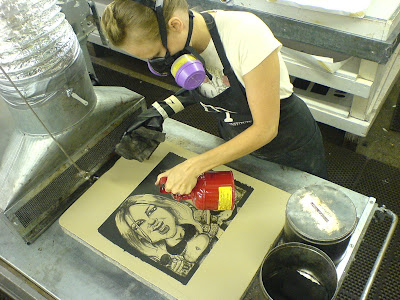Apparently, no matter how much explaining I do, some people still don't understand what I'm doing at Tamarind. I figured I'd try throwing in some video clips to supplement my explanations. Sorry, I don't have a way to edit them right now.
Anytime we go to print a stone or a plate, there are several steps we have to take. At this point, the stone has had it's first and second etches applied, is rolled up with ink, and stored under a thin, buffed-in layer of gum arabic. (See picture above for reference.)
The first thing we do is apply a fresh layer of gum arabic and buff it in. After it dries, we take lithotine or some sort of other solvent and remove all of the ink that it was rolled up in. The gum layer is not affected by this and will protect the non image areas from grease. In this first clip, Valpuri has already poured the lithotine on and is in the process of wiping out the ink.
After the ink is removed, we replace it with a thin coat of asphaltum, which serves as a printing base. Here you see Valpuri applying asphaltum to the image area, then buffing it in with a rag until there is a thin even coat.
Once the asphaltum dries and sets, the stone is ready to be washed out with water. The water will remove the previously applied gum from the non image areas and will leave the thin layer of asphaltum as a printing base in the image areas. You'll notice that Valpuri will first clean out the borders and then commit the image area. After it is relatively clear, she grabs the inking roller and rolls quickly, simultaneously snapping out the remaining asphaltum and inking the image.
With the stone satisfactorily inked, we're ready to pull a print on newsprint. Usually, we'll pull at least three or four newsprints, slowly adjusting our inking and pressure until it looks fairly good. This way we don't waste any of our expensive good paper. In this next clip, Valpuri has already placed a piece of newsprint over the inked image. She has also put down a tympan (greased piece of plastic) on top of the newsprint that will protect the paper as it is run through the press. Printing happens in several steps:
1) The press bed is guided to a marked starting point.
2) A lever is pulled down to apply pressure to the stone.
3) A clutch is engaged and a handle cranked to run the stone through the press.
4) At the marked end point, cranking is stopped and the pressure disengaged.
5) The pressbed is then pulled back to it's starting point.
6) The tympan is removed and the newsprint or paper is peeled off the stone.
Friday, September 21, 2007
Romancing the Stone
Posted by
Porkchop
at
8:57 PM
![]()
Subscribe to:
Post Comments (Atom)


1 comment:
Is she a robot woman?
Post a Comment